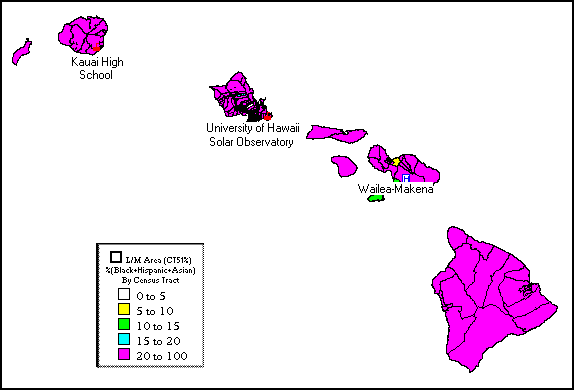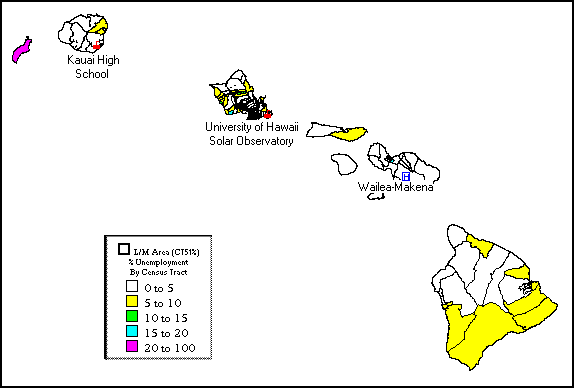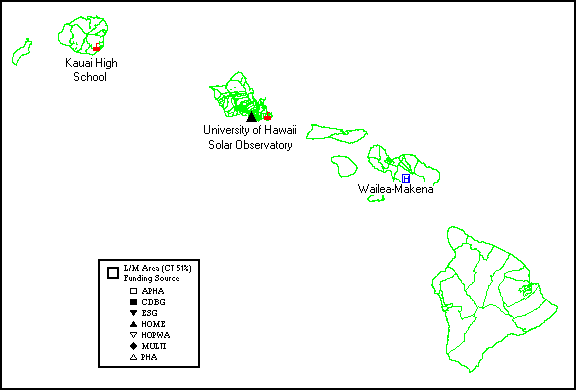

The State of Hawaii, 2,400 miles west of California, was the last State admitted to the Union on August 21, 1959. The State is a 2,000 mile long archipelago with eight major islands. Hawaii has the most diverse racial and ethnic population in the nation, the majority of which are Asian and Pacific Islanders. Due to the scarcity of land and high construction costs, Hawaii has one of the most expensive housing markets. The economy has been heavily dependent upon tourism, agriculture, and the military. Because of its unique location and workforce, Hawaii is an active partner in the Pacific Rim economy.
In its Consolidated Plan, the State of Hawaii describes its affordable housing and homeless shelter needs, with an emphasis on the counties of Hawaii, Maui, and Kauai. For the first year of the plan, Hawaii is requesting $3,000,000 in HOME Investment Partnership Program (HOME) funding, and a $135,000 Emergency Shelter Grant (ESG). It does not include a Community Development Block Grant (CDBG) application.
The HOME and ESG allocations will be distributed to the counties of Hawaii, Maui, and Kauai, to fund homeless and housing activities within their jurisdictions in 1995. These jurisdictions are required to submit their own separate Consolidated Plans for the CDBG program. The City and County of Honolulu prepares and submits its own Consolidated Plan for the CDBG, HOME, and ESG programs.
Developing the State of Hawaii's Consolidated Plan began by asking selected county and State departments for information on their agency's or county's priorities, plans, and anticipated funding for the coming fiscal year. A working group, with participants from government agencies and private service providers, met on February 16, 1995.
On February 9 and 10, 1995 the State Housing Finance and Development Corporation (HFDC) announced a public hearing on the proposed Citizen Participation Plan with notices in six Hawaiian newspapers. The hearing was held February 24. On March 2 and March 6, the HFDC published notices in six newspapers announcing a public comment period, to end on April 6, 1995, on the State's proposed Consolidated Plan.
The eight main islands of the State of Hawaii are 2,400 miles from the U.S. mainland, at the southeastern end of the 130-island, 1,500-mile long Hawaiian Islands chain. The State's 1990 resident population was 1,108,229. The island of Oahu (the "City and County of Honolulu" as one political jurisdiction) is the most developed, with 836,231 residents, three-quarters of the State's population. The three counties which are to be the recipients of the State's HOME and ESG allocations are:
The 1994 median income for a family of four in the respective counties in the State are: County of Hawaii - $38,800; County of Maui - $49,300; County of Kauai - $47,300; and City and County of Honolulu - $53,000.
In 1990, based upon HUD adjusted household income limits, about 36 percent of the State's households fell into the 80-percent-and-below income category. By counties, the percentages of such low- and moderate-income households are: Hawaii - 46 percent; Maui - 36 percent; Kauai - 39 percent; and Honolulu - 35 percent.
Hawaii's population is a unique mix of racial and ethnic backgrounds. Asian and Pacific Islanders are the largest racial or ethnic group. In 1990, 55 percent of all households were Asian/Pacific Islander, followed by the second largest group, white (non-Hispanic) with 37 percent of households. The pattern of racial/ethnic distribution in the counties of Hawaii, Kauai, and Maui are similar to that of the State.


Hawaii has experienced a persistent shortage of affordable housing. The prices of single-family homes and condominium units increased dramatically between 1980 and 1990. Rental rates skyrocketed. Rental vacancy rates dropped to as low as 1 percent in areas experiencing economic growth.
For low- to moderate-income households, there is a projected housing demand for 17,307 units for the six years 1995 to 2000. Of this, the estimated demand for housing for lower-income households (0 to 50 percent of MFI) is 8,821 units, starting in 1995 with about 1,434, and approximately 1,450 each additional year. For moderate-income families (51 to 80 percent of MFI), the demand is for 8,486 units in six years, or approximately 1,380 per year now, rising to 1,450 by 2000.
In 1990, there were a total of 389,810 year-round housing units in the State. Housing stock by county is: Maui - 42,261 units; and Hawaii - 48,253 units. For Kauai, before Hurricane Iniki in 1992 there were 17,613 year-round units; post-Iniki, there are 16,757 units remaining.
The State's population continues to grow, and increased 14.9 percent between 1980 and 1990, from 964,691 to 1,108,229. Growth rates for the State's out-lying counties (islands) are higher than both those of the State overall, or of the county of Honolulu, the most populous and urban of the islands. The 1990 populations and 1980 to 1990 growth rates for the counties were:
Hawaii County -- 120,317 persons, up 30.7 percent.Statewide, the average monthly rent in 1992 was $793. By county, average rents were: Hawaii - $556; Maui - $730; Kauai - $807 (pre-Iniki); and Honolulu - $864.
In 1992, the average resale price for an existing single-family unit was $344,695, down slightly from an average of $361,532 in 1991. Average resale prices in East and West Hawaii, Kauai, and Maui for 1992 were:
East Hawaii -- single family, $136,641; multifamily $82,669Typically, newly constructed housing units were lower-priced than resale units. The average sales price for a new single-family home, Statewide in 1992, was $274,545, up 14.5 percent from the 1991 average of $239,739. Average new home prices in 1992 were:
East Hawaii -- single family, $143,442; multifamily, $136,165.Paying more than 30 percent of gross household income for housing expenses is the most common housing problem. Severely cost-burdened households are those paying more than 50 percent of their income for housing. A significant portion of the State's 113,294 low- and moderate-income households are cost burdened. Among very low-income households (0 to 30 percent of median family income), 62 percent are cost burdened and 48 percent are severely cost burdened. Of the low-income households (31 to 50 percent of median), 50 percent are cost burdened and 23 percent are severely cost burdened. Moderate-income households (51 to 80 percent of median) are less likely to be cost burdened; only 37 percent are burdened and 10 percent severely cost burdened.
Renter households with cost burdens are often in critical need of assistance to retain the housing they occupy or to locate more affordable opportunities. Many owner households are also cost burdened, especially lower-income households and elderly owners, who often have difficulty meeting monthly mortgage and operating expenses.
Statewide in April, 1992, there were 5,353 homeless persons. In the County of Hawaii there were 1,244; in the County of Maui, 506; and in the County of Kauai, 363. On the more urbanized island of Oahu (the city and county of Honolulu), 3,240 homeless were counted.
Many of the homeless are young males, likely to be unmarried and living alone, either unemployed or underemployed. Many are Caucasian or part-Hawaiian, and relatively recent arrivals in Hawaii. The fact that they are recent arrivals is probably related to the likelihood that their support networks are very small or non-existent. Lifetime residents of the State are much less likely to be homeless.
About 8 percent of all the people in Hawaii are among the hidden homeless. But for the kindness of friends and relatives, the good fortune of finding shared housing, or having their housing paid for by the government, these people, too, would be homeless. They live in crowded conditions, doubled-up with other family members or sharing housing with unrelated persons.
More than a quarter (28 percent) of Hawaii's people live close to the edge of homelessness. They report that, if the primary wage earner in the household were to become unemployed, they would be able to make only three or fewer rent or mortgage payments before being evicted.
About 36 percent of Hawaii's homeless are members of families. The remainder are individuals not part of a family group. Of the individuals, about 22 percent are youths aged 17 or less, and 78 percent are adult homeless, aged 18 or older.
The need for homeless facilities is great. Over 60 percent of the homeless, both families and individuals, are unsheltered at any given time. The unsheltered homeless in Hawaii can be found mostly on beaches or in parks.
Shelter beds and transitional housing for homeless persons and families are in short supply in the outer counties.
There is also a need for supportive services for the homeless, including those with special problems related to substance abuse, mental illness, domestic abuse, and AIDS and related diseases. All homeless families and individuals need counseling and training targeted at helping them to achieve a sustainable level of independent living.
Factors prompting the shortage of affordable housing include demographic changes, market forces, changes in Federal tax policy, and restraints on housing development. The restraints include a lack of reasonably priced developable land, lack of infrastructure, high costs of development, government regulations, community opposition, and growing environmental requirements.
Specific barriers include:
The use of lead-based paint (LBP) in homes was banned in 1979. An indicator of the number of dwellings which may contain LBP hazards is the number of units built before 1980. About 284,000 of Hawaii's housing units were built before 1980. Of these, 92,350 were occupied by lower- and moderate-income renter households.
The State Department of Health investigates reports of high blood-lead levels in children to determine the source of the lead. Other children in the area are then screened for lead poisoning. An on-going childhood lead-poisoning prevention committee meets regularly. There is a need to abate LBP hazards during rehabilitation of pre-1980 housing, especially that of lower-income families with children.
Housing data show that most of Hawaii's housing problems stem from an inadequate supply of affordable housing. This shortfall has led to high rents and sales prices, relatively low vacancy rates, overcrowding, and households living in units with housing problems. General Statewide priorities include:
The HFDC anticipates allocating its 1995 HOME funds among the counties of Hawaii, Maui, and Kauai. The projected accomplishment, for the portion of HOME funds spent on new construction, is that about 75 new units are expected to be assisted over the next five years.
The portion of HOME funds used to develop new housing should also help produce about 10 units of housing for nonhomeless persons with special needs (age, physical or mental handicaps, etc.).
The HFDC anticipates that about 15% of HOME funds will be used in assisting first-time homebuyers. It is projected that approximately 50 homebuyers may be assisted in the next five years.
The HFDC expects that approximately 5 percent of the HOME monies allocated to the counties will be used for loans to assist lower-income homeowners rehabilitate their housing. It is projected that about 40 such units will be assisted in the next five years.
The Hawaii Housing Authority (HHA) anticipates that the State will be eligible for $135,000 in ESG funding annually over the next five years. The HHA expects that the counties will use about 5 percent of their allocations to help prevent low-income families from becoming homeless with grants or loans for rent or security deposits.
HHA anticipates that the counties allotted ESG funds will use about 15 percent for outreach to homeless persons and for assessing their needs, in conjunction with the State-funded "Care-a-Van" program. It projects that ESG-funded counties will use approximately 75 percent to their allocated funding to address emergency shelter and transitional housing needs of the homeless. Measures may include the development of new shelter space (either through leasing facilities or new construction), assisting shelters with their operating expenses, and supportive services.
HHA expects that the counties will provide services to help homeless persons with special needs to make the transition to independent living. Support would include building their life skills through tenant-landlord relations, budgeting, literacy, anger management, and substance abuse counseling.
The State of Hawaii's antipoverty strategy focuses on three approaches: meeting basic subsistence requirements for food, shelter, clothing, and medical care; family strengthening and preservation; and self-empowerment. Self-empowerment programs help clients develop the skills, ability, and self-confidence in order to reach self-sufficiency and economic independence, with jobs which pay adequate wages to minimize the need for public assistance. Support programs for homeless persons ideally would include much of this strategy.
The Hawaii Housing Authority will monitor sub-recipients of Emergency Shelter Grant money to ensure compliance with all ESG requirements. The program specialist assigned to the ESG program will monitor submission of required reports and other documents, including an interim report which projects how the allocated funds will be used.
The HFDC anticipates distributing the 1995 HOME funds among the counties of Hawaii, Maui, and Kauai, which would then be the fourth such distribution since 1992. The HFDC will conduct monitoring visits to review the HOME-assisted projects funded by the three counties. The HFDC and the counties will conduct joint site visits of each HOME-assisted project. Visits are to include a physical inspection of each assisted unit, and interviews with property managers to determine compliance with property standards, tenant income requirements, and affirmative marketing requirements. Based upon the results of the initial inspections, it will be decided whether further inspections will be conducted by the counties or if joint visits will continue.

The State of Hawaii plans to distribute an estimated $3,135,000 in HOME Investment Partnership Program (HOME) and Emergency Shelter Grant (ESG) monies directly to the counties of Hawaii, Maui, and Kauai.
A projected Emergency Shelter Grant of $135,000 will be divided equally among the three counties. Each will be allocated $44,100, including $42,750 for program activities to benefit the homeless and $1,350 towards administrative expenses. The Hawaii Housing Authority will retain $2,700 to help cover its administrative overhead.
The counties will use their ESG funds to:
The counties will make the ESG funds competitively available to private nonprofit agencies that provide shelter and services to the homeless.
Each county has identified unique needs. Kauai continues its efforts to recover from Hurricane Iniki. The County of Hawaii has 22 percent of the State's homeless. Maui has only one nonprofit organization providing emergency shelter and transitional housing for the homeless.
The anticipated $3,000,000 in HOME funding is expected to be distributed by the State directly to the counties of Hawaii, Maui, and Kauai. Each county is anticipated to be given $963,000. Of this, $813,000 is to fund programmed activities, and $150,000 is a set-aside for a local community housing development organization (CHDO). Counties may chose to use up to $63,000 for administrative expenses; the State Housing Finance and Development Corporation (HFDC) will retain $111,000 towards administrative expenses related to this program.
Based upon the types of projects that have been committed or are planned, it is estimated that $1.8 million of the HOME funding will be used for construction of rental housing; $1.2 million is expected to be used for homeownership programs.
In 1993, a $30,000 HOME Technical Assistance Grant was used to provide technical assistance to the counties of Kauai, Maui, and Hawaii. The funds paid for a consultant to help each county to:
Hawaii's 1995 HOME and ESG allocations, with the exception of that part retained at State level for administrative expenses, is expected to be used in the three sub-recipient counties. The exact location of the planned activities in these counties was not known when the State Consolidated Plan was prepared.
The lead agencies, designated to coordinate and monitor Action Plan activities, will be the Hawaii Housing Authority for the ESG program, and the State of Hawaii's Housing Finance and Development Corporation for HOME efforts.
Housing Finance and Development Corporation
677 Queen Street, Suite 300
Honolulu, HI 96813